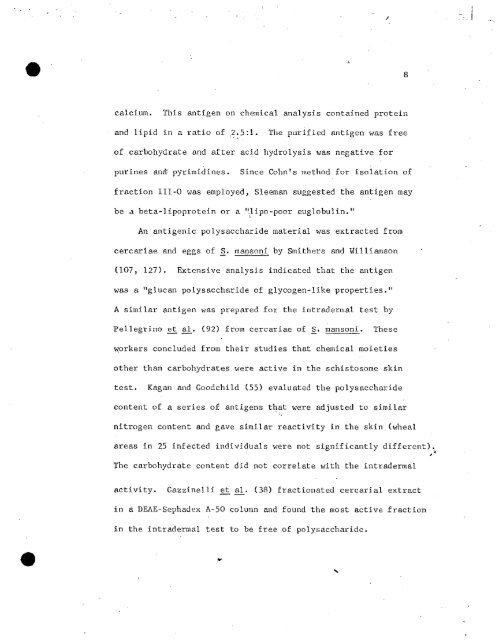CHARACTERIZATION OF PARASITE ANTIGENS ... - PAHO/WHO
CHARACTERIZATION OF PARASITE ANTIGENS ... - PAHO/WHO
CHARACTERIZATION OF PARASITE ANTIGENS ... - PAHO/WHO
Create successful ePaper yourself
Turn your PDF publications into a flip-book with our unique Google optimized e-Paper software.
e*<br />
*e.~~~~~~~~~~~~~ 8<br />
calcium. This antigen on chemical analysis contained protein<br />
and lipid in a ratio of 2.5:1. The purified antigen was free<br />
of carbohydrate and after acid hydrolysis was negative for<br />
purines and: pyrimidines. Since Cohn's method for isolation of<br />
fraction III-0 was employed, Sleeman suggested the antigen may<br />
be a beta-lipoprotein or a "'lipo-poor euglobulin."<br />
An antigenic polysaccharide material was extracted from<br />
cercariae and eggs of S. mansoní by Smithers and Williamson<br />
(107, 127). Extensive analysis indicated that the antigen<br />
was a "glucan polysaccharide of glycogen-like properties."<br />
A similar antigen was prepared for the intradermal test by<br />
Pellegrino et al. (92) from cercariae of S. mansoni. These<br />
workers concluded from their studies that chemical moieties<br />
other than carbohydrates were active in the schistosome skin<br />
test. Kagan and Goodchild (55) evaluated the polysaccharide<br />
content of a series of antigens that were adjusted to similar<br />
nitrogen content and gave similar reactivity in the skin (wheal<br />
areas in 25 infected individuals were not significantly different).<br />
The carbohydrate content did not correlate with the intradermal<br />
activity. Gazzinelli et al. (38) fractionated cercarial extract<br />
in a DEAE-Sephadex A-50 column and found the most active fraction<br />
in the intradermal test to be free of polysaccharide.
















